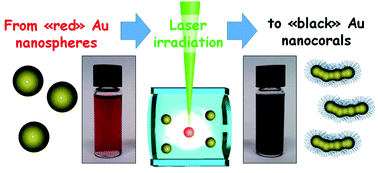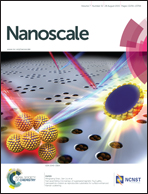Laser generated gold nanocorals with broadband plasmon absorption for photothermal applications
Abstract
Gold nanoparticles with efficient plasmon absorption in the visible and near infrared (NIR) regions, biocompatibility and easy surface functionalization are of interest for photothermal applications. Herein we describe the synthesis and photothermal properties of gold “nanocorals” (AuNC) obtained by laser irradiation of Au nanospheres (AuNS) dispersed in liquid solution. AuNC are formed in two stages: by photofragmentation of AuNS, followed by spontaneous unidirectional assembly of gold nanocrystals. The whole procedure is performed without chemicals or templating compounds, hence the AuNC can be coated with thiolated molecules in one step. We show that AuNC coated with thiolated polymers are easily dispersed in an aqueous environment or in organic solvents and can be included in polymeric matrixes to yield a plasmonic nanocomposite. AuNC dispersions exhibit flat broadband plasmon absorption ranging from the visible to the NIR and unitary light-to-heat conversion. Besides, in vitro biocompatibility experiments assessed the absence of cytotoxic effects even at a dose as high as 100 μg mL−1. These safe-by-designed AuNC are promising for use in various applications such as photothermal cancer therapy, light-triggered drug release, antimicrobial substrates, optical tomography, obscurant materials and optical coatings.


 Please wait while we load your content...
Please wait while we load your content...